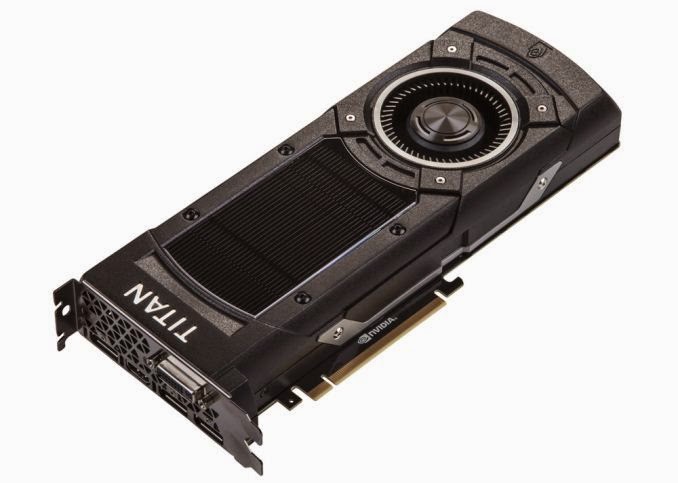
The NVIDIA GeForce GTX is back with another Titan, and this time they are looking to recapture a lot of the magic of the original Titan. First teased back at GDC 2015 in an Epic Unreal Engine session, and used to drive more than a couple of demos at the show, the GTX Titan X gives NVIDIA’s flagship video card line the Maxwell treatment, bringing with it all of the new features and sizable performance gains that we saw from Maxwell last year with the GTX 980. To be sure, this isn’t a reprise of the original Titan – there are some important differences that make the new Titan not the same kind of prosumer card the original was – but from a performance standpoint NVIDIA is looking to make the GTX Titan X as memorable as the original. Which is to say that it’s by far the fastest single-GPU card on the market once again.
NVIDIA has assembled a new Maxwell GPU, GM200 (aka Big Maxwell). We’ll dive into GM200 in detail a bit later, but from a high-level standpoint GM200 is the GM204 taken to its logical extreme. It’s bigger, faster, and yes, more power hungry than GM204 before it. In fact at 8 billion transistors occupying 601mm2 it’s NVIDIA’s largest GPU ever. And for the first time in quite some time, virtually every last millimeter is dedicated to graphics performance, which coupled with Maxwell’s performance efficiency makes it a formidable foe.
Diving into the specs, GM200 can for most intents and purposes be considered a GM204 + 50%. It has 50% more CUDA cores, 50% more memory bandwidth, 50% more ROPs, and almost 50% more die size. Packing a fully enabled version of GM200, this gives the GTX Titan X 3072 CUDA cores and 192 texture units(spread over 24 SMMs), paired with 96 ROPs. Meanwhile considering that even the GM204-backed GTX 980 could outperform the GK110-backed GTX Titans and GTX 780 Ti thanks to Maxwell’s architectural improvements – 1 Maxwell CUDA core is quite a bit more capable than Kepler in practice, as we’ve seen – GTX Titan X is well geared to shoot well past the previous Titans and the GTX 980.
the GTX Titan Black this is one of the few areas where GTX Titan X doesn’t have an advantage in raw specifications – there’s really nowhere to go until HBM is ready – however in this case numbers can be deceptive as NVIDIA has heavily invested in memory compression for Maxwell to get more out of the 336GB/sec of memory bandwidth they have available. The 12GB of VRAM on the other hand continues NVIDIA’s trend of equipping Titan cards with as much VRAM as they can handle, and should ensure that the GTX Titan X has VRAM to spare for years to come. Meanwhile sitting between the GPU’s functional units and the memory bus is a relatively massive 3MB of L2 cache, retaining the same 32K:1 cache:ROP ratio of Maxwell 2 and giving the GPU more cache than ever before to try to keep memory operations off of the memory bus.
As for clockspeeds, as with the rest of the Maxwell lineup GTX Titan X is getting a solid clockspeed bump from its Kepler predecessor. The base clockspeed is up to 1Ghz (reported as 1002MHz by NVIDIA’s tools) while the boost clock is 1075MHz. This is roughly 100MHz (~10%) ahead of the GTX Titan Black and will further push the GTX Titan X ahead. However as is common with larger GPUs, NVIDIA has backed off on clockspeeds a bit compared to the smaller GM204, so GTX Titan X won’t clock quite as high as GTX 980 and the overall performance difference on paper is closer to 33% when comparing boost clocks.
Power consumption on the other hand is right where we’d expect it to be for a Titan class card. NVIDIA’s official TDP for GTX Titan X is 250W, the same as the previous single-GPU Titan cards (and other consumer GK110 cards). Like the original GTX Titan, expect GTX Titan X to spend a fair bit of its time TDP-bound; 250W is generous – a 51% increase over GTX 980 – but then again so is the number of transistors that need to be driven. Overall this puts GTX Titan X on the high side of the power consumption curve (just like GTX Titan before it), but it’s the price for that level of performance. Practically speaking 250W is something of a sweet spot for NVIDIA, as they know how to efficiently dissipate that much heat and it ensures GTX Titan X is a drop-in replacement for GTX Titan/780 in any existing system designs.
Source: Anandtech
NVIDIA has assembled a new Maxwell GPU, GM200 (aka Big Maxwell). We’ll dive into GM200 in detail a bit later, but from a high-level standpoint GM200 is the GM204 taken to its logical extreme. It’s bigger, faster, and yes, more power hungry than GM204 before it. In fact at 8 billion transistors occupying 601mm2 it’s NVIDIA’s largest GPU ever. And for the first time in quite some time, virtually every last millimeter is dedicated to graphics performance, which coupled with Maxwell’s performance efficiency makes it a formidable foe.
Diving into the specs, GM200 can for most intents and purposes be considered a GM204 + 50%. It has 50% more CUDA cores, 50% more memory bandwidth, 50% more ROPs, and almost 50% more die size. Packing a fully enabled version of GM200, this gives the GTX Titan X 3072 CUDA cores and 192 texture units(spread over 24 SMMs), paired with 96 ROPs. Meanwhile considering that even the GM204-backed GTX 980 could outperform the GK110-backed GTX Titans and GTX 780 Ti thanks to Maxwell’s architectural improvements – 1 Maxwell CUDA core is quite a bit more capable than Kepler in practice, as we’ve seen – GTX Titan X is well geared to shoot well past the previous Titans and the GTX 980.
the GTX Titan Black this is one of the few areas where GTX Titan X doesn’t have an advantage in raw specifications – there’s really nowhere to go until HBM is ready – however in this case numbers can be deceptive as NVIDIA has heavily invested in memory compression for Maxwell to get more out of the 336GB/sec of memory bandwidth they have available. The 12GB of VRAM on the other hand continues NVIDIA’s trend of equipping Titan cards with as much VRAM as they can handle, and should ensure that the GTX Titan X has VRAM to spare for years to come. Meanwhile sitting between the GPU’s functional units and the memory bus is a relatively massive 3MB of L2 cache, retaining the same 32K:1 cache:ROP ratio of Maxwell 2 and giving the GPU more cache than ever before to try to keep memory operations off of the memory bus.
As for clockspeeds, as with the rest of the Maxwell lineup GTX Titan X is getting a solid clockspeed bump from its Kepler predecessor. The base clockspeed is up to 1Ghz (reported as 1002MHz by NVIDIA’s tools) while the boost clock is 1075MHz. This is roughly 100MHz (~10%) ahead of the GTX Titan Black and will further push the GTX Titan X ahead. However as is common with larger GPUs, NVIDIA has backed off on clockspeeds a bit compared to the smaller GM204, so GTX Titan X won’t clock quite as high as GTX 980 and the overall performance difference on paper is closer to 33% when comparing boost clocks.
Power consumption on the other hand is right where we’d expect it to be for a Titan class card. NVIDIA’s official TDP for GTX Titan X is 250W, the same as the previous single-GPU Titan cards (and other consumer GK110 cards). Like the original GTX Titan, expect GTX Titan X to spend a fair bit of its time TDP-bound; 250W is generous – a 51% increase over GTX 980 – but then again so is the number of transistors that need to be driven. Overall this puts GTX Titan X on the high side of the power consumption curve (just like GTX Titan before it), but it’s the price for that level of performance. Practically speaking 250W is something of a sweet spot for NVIDIA, as they know how to efficiently dissipate that much heat and it ensures GTX Titan X is a drop-in replacement for GTX Titan/780 in any existing system designs.
 Wlaptops
Wlaptops